

Bahrain US$8, Egypt US$8, Iran US$8, Iraq US$8, Jordan US$8, Kuwait US$8, Lebanon US$8, Oman US$8, Qatar US$8, Saudi Arabia US$8, Syria US$8, UAE US$8, Yemen US$8 Serving the region for over 40 years www.MiddleEastHealth.com
advanced healthcare
United
United States Hospitals – a Supplement to Middle East Health November- December 2022 SUPPLEMENT
Prolific biomed research forms foundation of
in
States
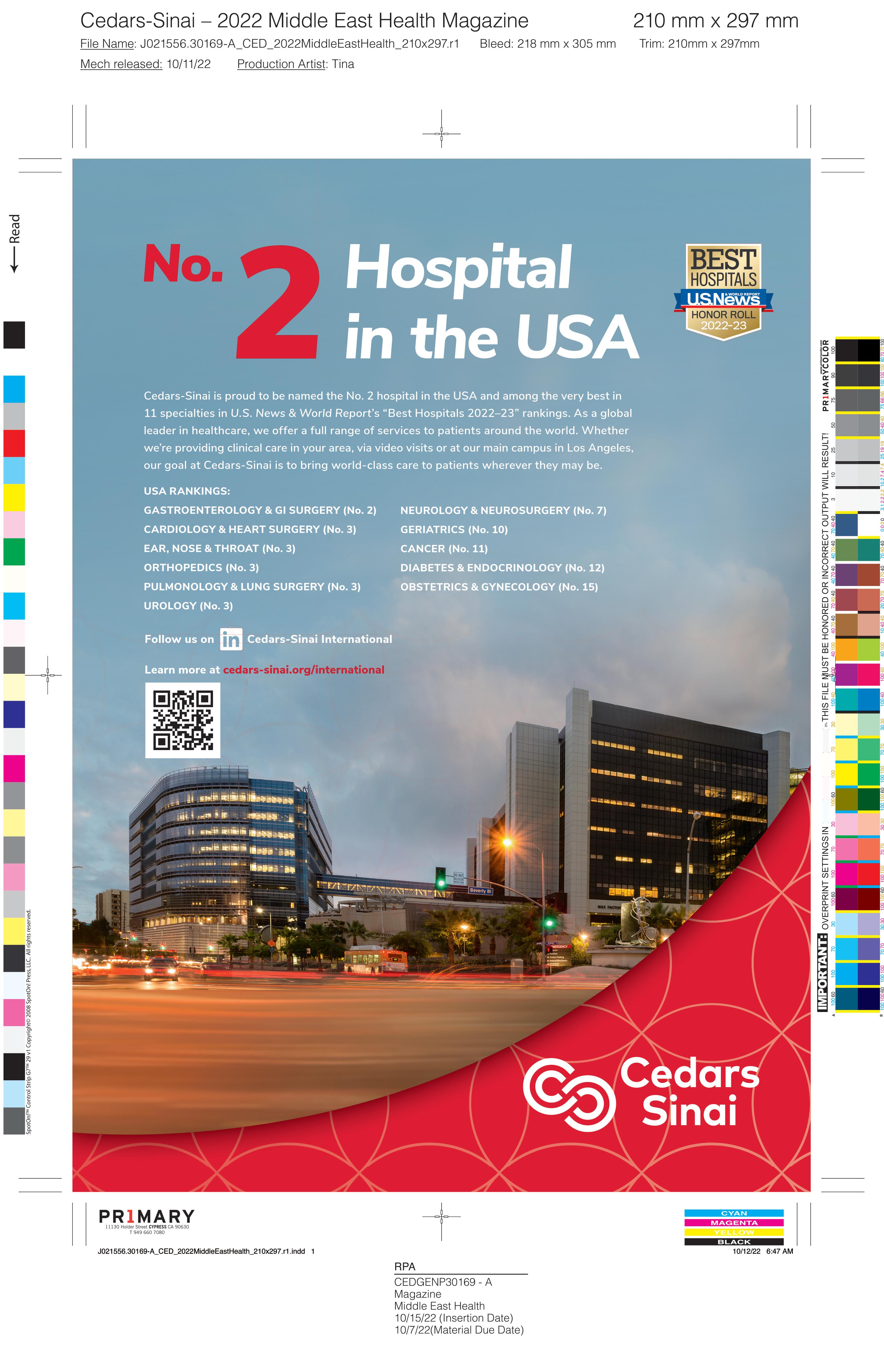
Publisher
Michael Hurst Michael@MiddleEastHealth.com
Editor
Callan Emery editor@MiddleEastHealth.com
Editorial Consultants
Dr Gamal Hammad, Dr Peter Moore, Harry Brewer
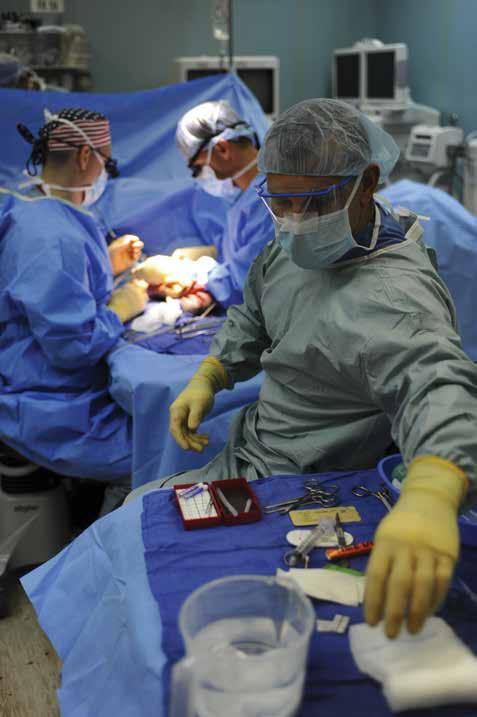
Middle East Editorial Office PO Box 72280, Dubai, UAE Telephone: (+9714) 391 4775 editor@MiddleEastHealth.com


Marketing Manager
Foehn Sarkar Telephone: (+9714) 391 4775 n Fax: (+9714) 391 4888 marketing@MiddleEastHealth.com
Subscription & Admin Manager
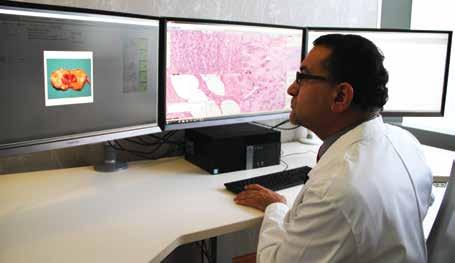
Savita Kapoor Telephone: (+9714) 391 4775 n Fax: (+9714) 391 4888 Savita@MiddleEastHealth.com
Advertising Sales PO Box 72280, Dubai, UAE marketing@MiddleEastHealth.com
Americas, France Joy Sarkar P O Box 72280, Building No.2 2nd Floor, Dubai Media City Dubai, United Arab Emirates Tel: +971 4 391 4775 Fax: +971 4 391 4888 Joy@MiddleEastHealth.com
Japan
Mr Katsuhiro Ishii Ace Media Service Inc 12-6, 4-chome, Adachi-ku, Tokyo 121-0824, Japan Tel: +81-3-5691-3335 n Fax:+81-3-5691-3336 Email: amskatsu@dream.com
China
Miss Li Ying Medic Time Development Ltd, Flat 1907, Tower A, Haisong Building, Tairan 9th Road, Futian District, Shenzhen, China 518048 Tel: +86-755-239 812 21 n Fax: +86-755-239 812 33 Email: medic8@medictime.com
Taiwan Larry Wang
Olympia Global Co Ltd 7F, No.35, Sec 3, Shenyang Rd, Taichung Taiwan 40651 n P O Box: 46-283 Taichung Taiwan 40799 Tel: +886- (4)-22429845 n Fax:+886- (4)-23587689
Email: media.news@msa.hinet.net
Middle East Health is published by Hurst Advertising FZ LLC , Dubai Media City, License Number: 30309 UAE National Media Council - Approval Number: 2294781
Middle East Health online www.MiddleEastHealth.com
Middle East Health is printed by Atlas Printing Press. www.atlasgroupme.com
MIDDLE EAST HEALTHI 1 November - December 2022 Serving the region for 40 years centered care 14 Northwell Health
United States leads the way in biomedical research and clinical practice

There are several reasons why the United States is so attractive to so-called medi cal tourists – patients travelling from other countries to the United States to seek medical treatment. Foremost is the advanced treatment they can expect to receive, particularly for complex cases. Such treatments are often not available in their home countries. Secondly, leading hospitals in the US employ some of the world’s most advanced specialists in their fields and as such can be trusted to provide the best medical expertise available in the world.
Third, leading hospitals in the United States house some of the world’s most advanced medical technology. It is this combination of expertise and advanced MedTech that helps ensure patients re ceive an accurate diagnosis and the best treatment outcomes.
Fourth, the amount of funding given over to biomedical research is phenom enal, both from the private sector and the public sector. The National Institutes of
Health is the largest public funder of biomedical research in the world, investing more than US$32 billion a year.
For example, the NIH Director’s Awards totaling approximately $285 million was announced in October. The High-Risk, High-Reward Research pro gram, supported by the Common Fund at the National Institutes of Health awarded 103 new research grants to support highly innovative scientists who propose vision ary and broadly impactful biomedical research projects. Awards this year include, among others, the impact exposure to fracking might have on pregnancy and conception; how brain mechanisms influence memory performance; tissue regeneration using the uterus as a model; and a new model organism to lead in the devel opment of an HIV vaccine.
The NIH explains that the High-Risk, High-Reward Research program supports investigators at each career stage who propose innovative research that, due to their inherent risk, may struggle to raise
support in the traditional NIH peer-review process despite their transformative potential. Investigators seeking program support are encouraged to think beyond traditional bounds and to pursue trailblazing ideas in any area of research relevant to the NIH’s mission to advance knowl edge and enhance health.
It is inspiring to see how many of these research projects regularly come to frui tion. Looking at the sheer number of re search projects achieving results – the NIH announces the publication of several of these completed and published studies each week – it is clear how rapidly inno vation in healthcare is evolving in the United States.
Bionic pancreas
For example – and there are many examples – a new NIH-funded multicenter clinical trial <https://doi.org/10.1056/NEJ Moa2205225> has found that a bionic pan creas, which uses next-generation technology to automatically deliver insulin, was
2 IMIDDLE EAST HEALTH

more effective at maintaining blood glucose levels within the normal range compared to standard-of-care management among people with type 1 diabetes.
Compared to other available artificial pancreas technologies, the iLET bionic pancreas requires less user input and provides more automation because the de vice’s algorithms continually adjust insulin doses automatically based on users’ needs. Users initialize the bionic pancreas by entering their body weight into the device’s dosing software at the time of first use. Us ers of the bionic pancreas also do not have to count carbohydrates, nor initiate doses of insulin to correct for high blood glucose. In addition, healthcare providers do not need to make periodic adjustments to the settings of the device.
Four type 2 diabetes drugs compared
In another NIH-funded and recently published study < https://doi.org/10.1056/ NEJMoa2200433 > researchers directly compared four drugs commonly used to treat type 2 diabetes. The researchers note that while there is general agreement among healthcare professionals that met formin combined with diet and exercise is the best early approach in diabetes care, there is no consensus on what to do next to best keep high blood glucose in check.
Launched in 2013, the Glycemia Re duction Approaches in Diabetes: A Comparative Effectiveness (GRADE) Study was conducted at 36 US study centers. It was designed to compare four major medi cations approved by the FDA at the time GRADE started to treat diabetes in combination with metformin. The study found that participants taking metformin plus li raglutide or insulin glargine achieved and maintained their target blood levels for the longest time compared to sitagliptin or glimepiride. This translated into approxi mately six months more time with blood glucose levels in the target range compared with sitagliptin, which was the least effec tive in maintaining target levels. The study also looked at the treatments’ effects on developing diabetes-related cardiovascular disease. Researchers found that participants in the liraglutide group were least likely to experience any cardiovascular disease overall compared to the other groups.
Sleep and the immune system
Another recently published study < https:// doi.org/10.1084/jem.20220081 > funded by
the NIH looks at the importance of sleep and found that it supports normal production and programming of hematopoietic stem cells, a building block of the body’s innate immune system. In other words, getting a good night’s sleep supports the body’s immune function. The study authors note that what they are learning is that sleep modulates the production of cells that are the protagonists of in flammation and that good, quality sleep re duces that inflammatory burden.
Umbilical cord milking
NIH-funded research is astoundingly prolific. Yet another recently completed study < https:// doi.org/10.1016/j.ajog.2022.08.015 > suggests that a treatment to move blood from the um bilical cord into an infant’s body may improve the overall health of newborns classified as non-vigorous – limp, pale and with minimal
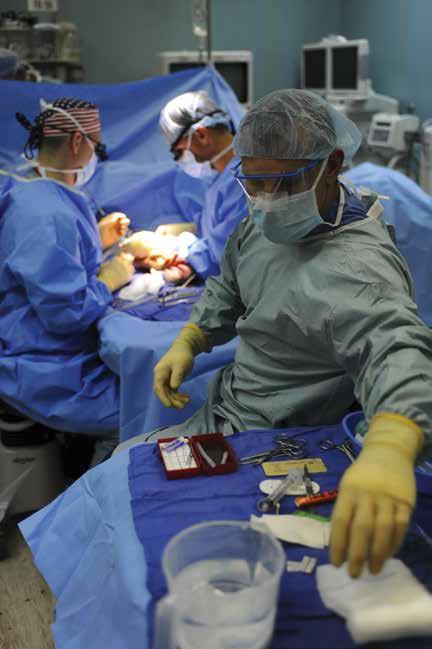
breathing. The procedure, known as umbilical cord milking, involves gently squeezing the cord between the thumb and forefinger and slowly pushing the blood into the abdomen. Compared to non-vigorous infants receiving the standard treatment of immediate um bilical cord clamping, infants who underwent cord milking were less likely to need heart and respiratory support, less likely to have a low level of oxygen in the brain, and more likely to have higher levels of hemoglobin.
Biomedical research is imperative to advancing healthcare and when this is carried over into clinical practice it is the patients who benefit with the best treatment outcomes. The United States is clearly a world leader in this regard and this is evidenced in the exceptionally high standard of clinical practice provided by leading hospitals in the United States.
4 IMIDDLE EAST HEALTH
Cedars-Sinai
Cedars-Sinai proud to be No. 2 hospital in the USA
Cedars-Sinai is truly honored to be named the No. 2 hospital in the USA on U.S. News & World Report’s Best Hospitals Honor Roll. We’re also proud to be ranked among the best in the USA in the following 11 specialties: Gastroenterology and GI Surgery; Cardiology & Heart Surgery; Ear, Nose & Throat; Orthopedics; Pulmonology and Lung Surgery; Urology; Neurology and Neurosurgery; Geriatrics; Cancer; Diabetes & Endocrinology; and Obstetrics and Gynecology.
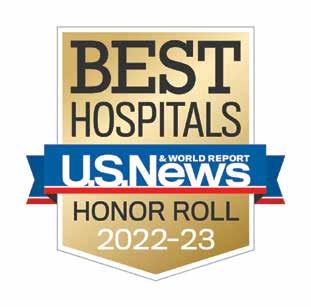
In addition, we’ve been named the No. 1 hospital in California and No.1 in five specialties in California–Cardiology and Heart Surgery, Gastroenterology and GI Surgery, Orthopedics, Pulmonology and Lung Sur gery, and Urology. Our Neurology & Neurosurgery specialty has also been ranked No. 1 in the Los Angeles region.
The U.S News rankings are based on patient outcomes, patient experience, technology, reputation (according to surveyed physicians) and a variety of other health-related measures. They reflect the tireless commitment of all those who work and practice at Cedars-Sinai to deliver the highest-quality patient care, es pecially during the challenging times of the COVID-19 pandemic.
Located in West Los Angeles, California, in the beautiful neighborhood of Bev
erly Hills, Cedars-Sinai is part of a diverse and lively city, known for its art, culture, music, sporting events, cultural landmarks and warm weather.
Every year, thousands of patients from around the globe receive treatment at Cedars-Sinai. We offer new treatments, surgeries and clinical trials that are only available at a few hospitals in the U.S. We treat each patient with an individualized treatment plan. Patients at Cedars-Sinai can expect the best available care, a per sonal approach, and the newest diagnos tics and treatment options.
“Thanks to the dedication of our physicians, nurses, academic leaders and thou sands of others on our staff, Cedars-Sinai continues to provide innovative healthcare, enhanced by our commitment to pioneering research, teaching and education,” said Thomas M. Priselac, president and CEO of Cedars-Sinai Health System. “We are proud of Cedars-Sinai’s contributions to our diverse Los Angeles community as well as nationally and globally.”
International patients
As part of this commitment to our global community, Cedars-Sinai International has a dedicated patient-services team that speaks multiple languages and focuses specifically on helping our international patients. We
provide a range of concierge services to meet the unique needs of patients traveling from outside the U.S. to receive world-class care and treatment at Cedars-Sinai.
Our global-services team leverages the clinical and nonclinical excellence at Cedars-Sinai to provide a full spectrum of advisory and consulting services that help our partners around the world achieve their strategic goals and thrive in today’s everchanging healthcare environment.
“Today, we care for patients from over 100 countries. Our top areas are heart and cancer, as well as neurological diseases, orthopaedics, gastrointestinal diseases, transplant surgery and women’s health,” said Heitham Hassoun, MD, vice president and medical director of Cedars-Sinai International. “Whether through receiving care at our state-of-the-art facilities in Los Ange les or through remote second opinions and teleconsultations, we want international patients to benefit from our services wherever they live.”
Cedars-Sinai would like to thank our staff for earning this global recognition. They are true leaders within their fields, and their innovation and compassion are unparalleled. We’re so grateful to each and every one of them for sharing their expertise and always keeping our patients’ wellbeing as their top priority.

• Follow us on at: Cedars-Sinai International
• Learn more about Cedars-Sinai at: cedars-sinai.org/international
MIDDLE EAST HEALTHI 5
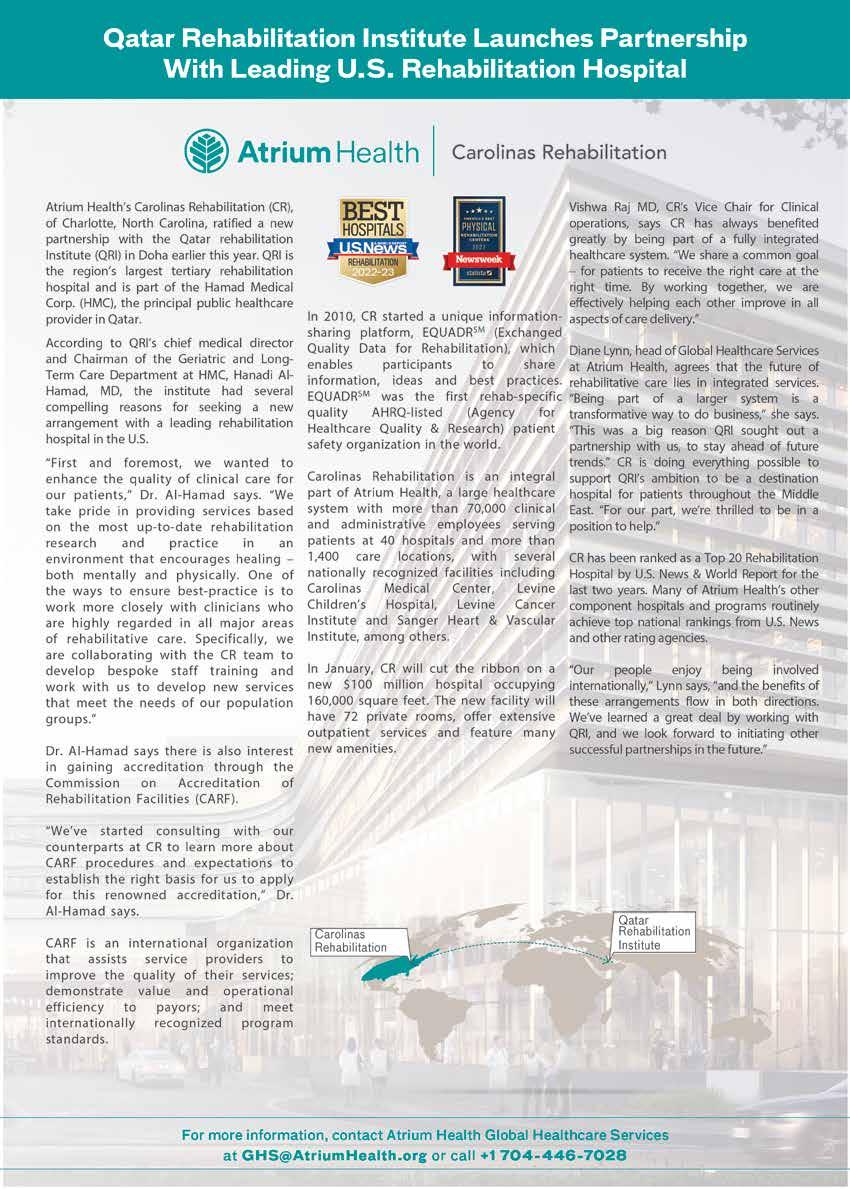

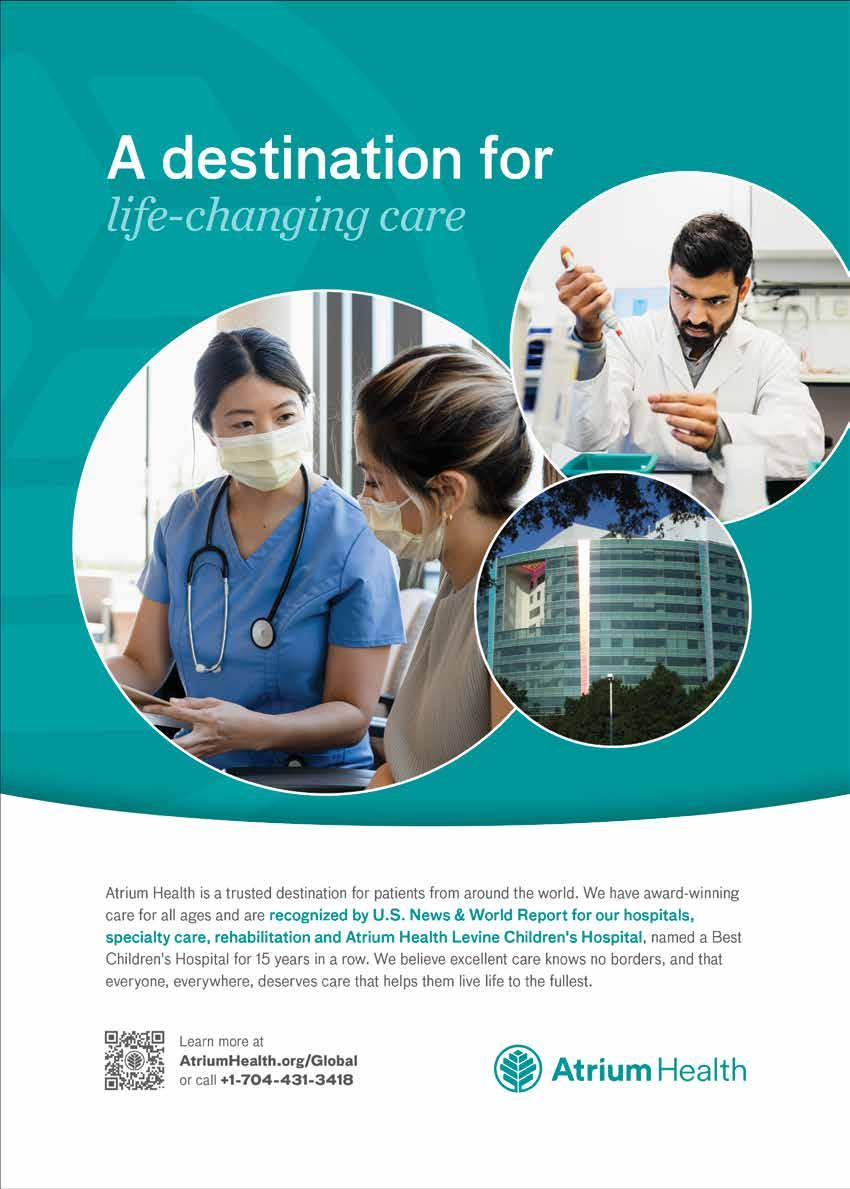
Baptist Health
Cardiac surgery reinvented
Landmark minimally invasive technique garners global attention at Miami Cardiac & Vascular Institute

 By John Fernandez
By John Fernandez
Most people are familiar with the com plexity and critical nature of “open-heart surgery” – whether it’s a triple, double, or a quadruple bypass. Of the estimated 350,000 coronary bypass surgeries per formed in the United States every year, most are still done as they were, more or less, since the 1970s.
“Typically, they’re done through what I call the zipper, an incision right down the middle of the chest, about 11 to 12 inches long, that divides the main bone on the sternum,” explains Joseph McGinn Jr., M.D., the chief of cardiac surgery at Miami Cardiac & Vascular Institute, who recent ly hosted a webinar appropriately titled, Cardiac Surgery Reinvented. “This (open heart) procedure has been around since the 1970s. So I developed this procedure, what I call MICS CABG.”
Thanks to Dr. McGinn, that generationsold approach to treat the severe narrowing of the arteries that supply oxygen and nutri ents to the heart will eventually be replaced – for most heart patients – by “minimally invasive cardiac surgery coronary artery bypass graft” – or MICS CABG. Dr. McGinn pioneered the procedure, and has advanced its benefits and applications since becoming chief of cardiac surgery at the Institute two years ago. The surgery involves an incision, about 2 to 3 inches long, made in the chest between two ribs, avoiding muscle and the need to break any bones.
The traditional “open heart surgery” can be grueling for patients, who often endure considerable pain and a recovery time of three months or longer. Most traditional bypass surgeries put patients on a heartlung machine so the heart can be stopped during the procedure. Dr. McGinn avoids this step. Instead, he uses specially engi-
the beating heart.
Worldwide interest in McGinn Technique
The McGinn Technique at Miami Cardiac & Vascular Institute has altered bypass surgery so much that Dr. McGinn and his team often draw national and international attention from surgeons seeking to learn more.
“We’ve gotten so much press about this, that we’ve had surgeons from all over the globe coming to watch how to do the case and learn the technique. And it’s gotten to a point where it’s being done just about everywhere in the globe. I’ve been all over the globe teaching and mentoring and helping surgeons learn how to do this pro cedure. And we’ve gotten to a point where we can just about do any patient this way.”
The minimally invasive approach contin ues to be refined, and available to most pa tients, with some limited exceptions, explains Dr. McGinn. There’s a chance that patients who are obese may not be good candidates for MICS CABG. Patients with peripheral vascular disease or advanced diffuse coronary disease may also not be suitable.
anybody that you would not operate on?” said Dr. McGinn. “Typically, emergency cases come in different flavors. If it’s a real dire emergency – no, we will not do it this way. But if it’s a moderate emergency – yes, we can do it minimally invasive. We do about 98 percent to 99 percent of our pa tients minimally invasive. We do the most minimally invasive coronary bypass in the country, probably the world.”
Dr. McGinn emphasizes that the No. 1 concern of bypass surgery patients is pain.
“You would think that a life-threatening surgery, the biggest concern would be: Am I going to die? Or: Am I going to make it through the surgery? It turns out that it wasn’t. No. 1 was: ‘How much pain am I going to have?’ And then the question was, ‘What’s my quality of life after I have this life-threatening surgery?’ Quality of life has trumped death as far as most patients are concerned in our current society … I get a lot of people who seek me out be cause our procedure can literally get them back to normal activity about a week after discharge.”
8 IMIDDLE EAST HEALTH

University of
Chicago Medicine
Bringing cutting-edge healthcare to the world
At the forefront of medicine since 1927
With a history dating back to 1927, the University of Chicago Medicine has been advancing the forefront of health by bringing research closer to a more accessible re ality through the advanced treatment and care of our patients.
UChicago Medicine’s physicians and researchers have helped shape modern medicine. They’re proven pioneers in organ transplantation, the genetics of cancer, chemotherapy, and life-changing digestive disease treatments among many other breakthroughs. The 12 Noble Prize laureates affiliated with UChicago Medicine are fruition of our long tradition of groundbreaking medical research.
Today, UChicago Medicine operates four inpatient hospitals and 10 ambulatory facilities around the Chicago area, including downtown Chicago, the city’s south suburbs, and northwest Indiana. De veloping projects include plans to build a new $633 million, 500,000-square-foot freestanding cancer center and additional outpatient centers. We have about 1,200 doctors and 3,000 nurses who provide care across all medical and surgical specialties.
Clinical Centre of Excellence
At UChicago Medicine, we are committed to advancing medicine to offer patients the best treatments. Out of the 12 areas rated by U.S. News & World Report for its 2022-23 Best Hospitals list, the University of Chicago Medical Center ranked among the best in the country in 10 specialties. We offer a full spectrum of specialty care, including six clinical centers of excellence:
Comprehensive Cancer Center
Our Comprehensive Cancer Center is committed to exploring and developing innovative ways to prevent and treat cancer through
a collaborative research program. With more than 200 cancer specialists, cuttingedge research, and improved treatments, we are attacking cancer from every angle. Our organization is a National Cancer Institute-designated Comprehensive Cancer and nationally ranked by U.S. News & World Report. A few distinctions of the cancer center include:
• First site in U.S. to be certified for FDA-approved CAR T-cell therapies for specific blood cancers in both adult and pediatric patients. More than 150 patients have received these infusions so far.
• More than 200 bone marrow/stem cell transplants are performed each year, with a superior patient survival rates.
• One of the top three centers in the U.S. for Hyperthermic Intraperitoneal Chemotherapy (HIPEC) for both adult and pediatric patients.
• Novel therapies and treatment plans for HPV-associated head and neck cancers.
• One of the country’s first centers to offer Peptide Receptor Radionuclide Therapy for neuroendocrine tumors.
• Approximately 100 Whipple proce dures are performed each year for pancreatic cancer patients.
Transplant Institute
UChicago Medicine’s transplant program has a long history of breakthroughs that have defined the field. The health system’s Transplant Institute continues to be a world leader for lung, liver, kidney, pancreas, and islet transplantations with one of the shortest wait times and lowest mortality rates. Our experts use revolutionary approaches that produce exceptional outcomes. UChicago Medicine’s Transplant Institute is:
• A world leader in multi-organ trans plant for the sickest patients. More than one third of all the heart-liver-kidney triple organ transplants done in the U.S.
were performed at UChicago Medicine, including the world’s first back-to-back heart-liver-kidney transplant.
• One of the few centers offering liver autotransplant for tumors in hard-to-reach locations.
• The first hospital in Illinois to use ex vivo lung perfusion (EVLP) to prepare donor lungs for transplant, increasing the number of available donor lungs and decreasing the risk of life threatening complications.

• Offering the least-invasive technique for nephrectomy (kidney removal), which in volves making a single, small incision inside the belly button to conceal the scar afterward.
• One of a few U.S. hospitals to offer autologous islet cell transplantation after total pancreatectomy.
Heart and Vascular Center
UChicago Medicine has some of the nation’s best minds in cardiology, cardiac surgery, and vascular surgery. Newsweek ranked UChicago Medicine as one of the top 50 best hospitals in the world for cardiology care. We are known for our expertise in complex cardiovascular conditions and boast nationally acclaimed heart transplant, bloodless cardiac surgery, and robotic heart surgery programs with:

• The best heart transplant program in the U.S: 5-star rating from the Scientific Registry of Transplant Recipients (SRTR) for our expertise in heart transplants.
Volume: More than 1,000 heart transplants.
Shortest: The shortest wait times in the nation for receiving a donor heart.
Best: The best survival rates in the country for heart transplant patients (1-year adult patient survival: 100% - SRTR Jan. 2022).
• More than 300 bloodless cardiac surgeries.
• More than 2,000 procedures in robotic heart surgery.
10 IMIDDLE EAST HEALTH
A Cancer Center Designated by the National Cancer Institute
Comprehensive Cancer Center
Newsweek ranked UChicago
cal experts highly skilled in evaluating and treating the most complex and challenging nervous system disorders. Our physicians have demonstrated expertise in helping patients whose diagnoses are considered untreatable at other hospitals. The center is:
• A Comprehensive Stroke Center by the Joint Commission.
• A Level 4 Epilepsy Center by the Na tional Association of Epilepsy Centers.
• The nation’s first Center of Excellence for Cerebral Cavernous Malforma tions (CCM).
• One of the first hospitals to treat Parkinson’s disease with drug pumps and spinal and brain electrodes.
Musculoskeletal Center
UChicago Medicine offers a full range of orthopaedic care, with our surgeons, sports medicine specialists, physical therapists, and nurses working together to prevent, treat, and rehabilitate injuries and illnesses. Our or thopaedic center offers:
• The region’s premier orthopaedic oncology program treating tumors and cancer, with a distinguished history dating back over 50 years.
• Internationally renowned sports med icine program.
• The regional leader in minimally invasive spinal fusion surgery and one of the few centers using robotic technology in spinal cases.
• One of the nation’s leading centers, and the only Midwest training center, for robotic hip and knee replacement surgery.
Pediatric Care at Comer Children’s Hospital
The University of Chicago Medicine Comer Children’s Hospital provides innova-


tive medical care to children with all types of medical problems. We combine advanced technol ogy with a family-centered, kid-friendly philosophy, setting national standards of care for all children. We admit roughly 5,000 patients from the Chicago area, the Midwest, and around the world each year. Our hospital is:
• One of the country’s few centers to offer I131-MIBG therapy to neuroblastoma patients.
• First site in the U.S. to be certified for FDA-approved CAR T-cell therapies for specific blood cancers in both adult and pediatric patients.
• One of the nation’s most experienced pediatric epilepsy centers.
• First in the world to perform pediatric robotic bladder reconstruction.
• One of the largest pediatric cardiol ogy programs in the U.S. with over 600 pump cases performed annually.
Our commitment to the world UChicago Medicine is committed to pro viding the best treatment options and personalized services for international patients who come to Chicago for medical care. We also support the improvement of health care globally by bringing international standards and innovative practices to hospitals around the world.
Customized Care for International Patients

Our multilingual and culturally diverse team is dedicated to meeting our international patients’ needs, serving as a single point of contact before, during, and after their experience at UChicago Medicine. Our featured international patient services include:
• Clinical triage and management of
care by experienced medical directors.
• Scheduling of medical appointments.
• Escort of patients to medical appointments.
• Complimentary certified medical interpretation in more than 50 languages.
• Complimentary private airport pickup/drop-off.
• Complimentary private transportation to/from each medical appointment.
• Lodging arrangements with local ho tels, apartments, and corporate units at discounted rates.
• Assistance with cultural orientation and concierge services for dining and en tertainment.
International Collaboration
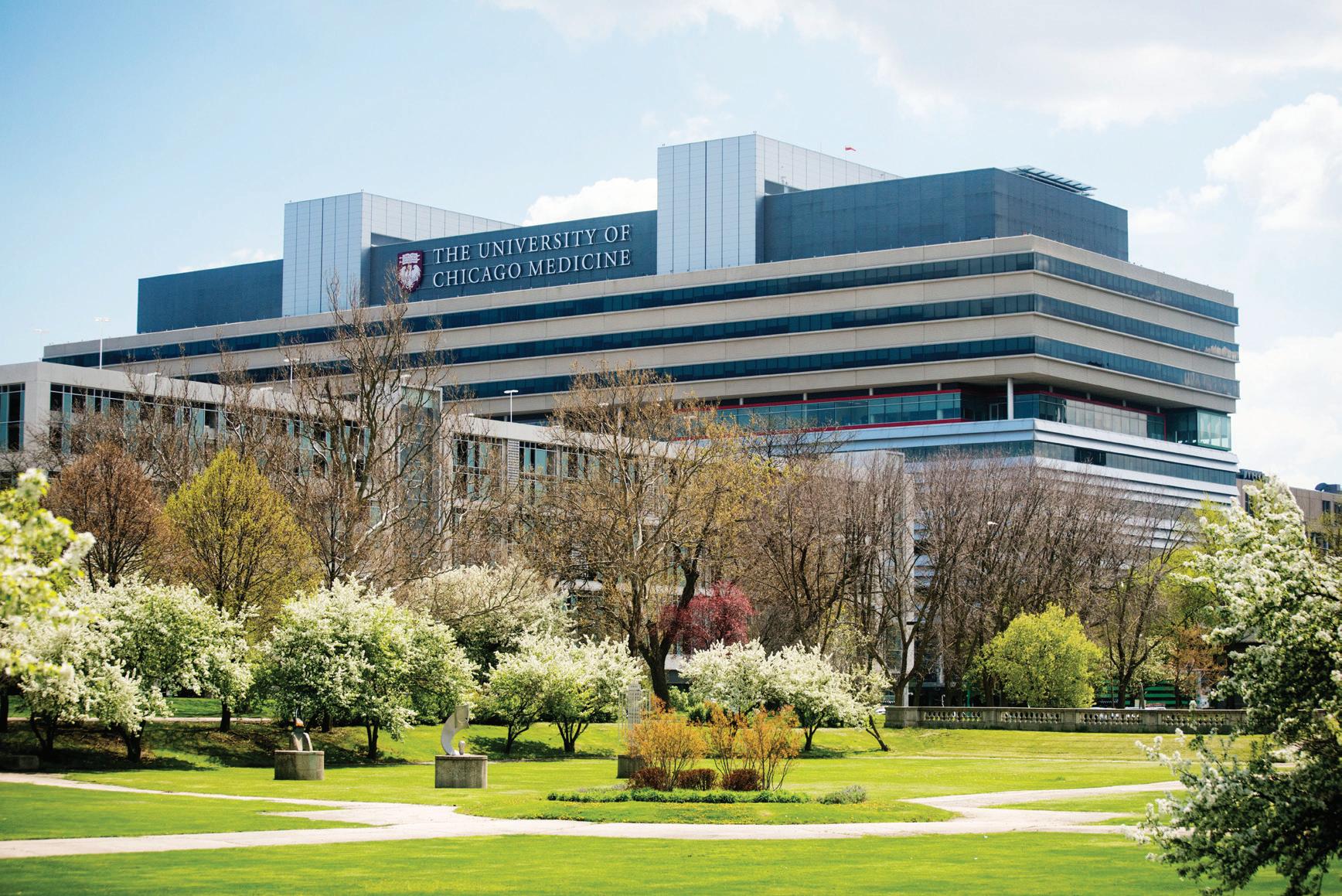
We have been building new bridges to bring UChicago Medicine’s unparalleled practic es to the rest of the world. We are committed to supporting our international partners to improve clinical quality and operational effectiveness through our tailored programs.
Examples of advisory projects to share our knowledge and skills include, but are not limited to:
• Facility planning and development
• Clinical and research program development
• Quality improvement and patient safety
•
Operational optimization
We also offer practical education and training programs customized to meet the specific needs of international healthcare organizations and professionals. The types of global education programs include:
• Leadership education
• Clinical observership program
• Global clinical conferences
• Hospital management training
Contact UChicago Medicine International Programs
If you want to learn more about UChicago Medicine’s International Programs, refer a patient, or explore collaborative projects with us, please visit our website at: https://www.uchicagomedicine.org/global or email us at international.services@uchospitals.edu
MIDDLE EAST HEALTHI 11
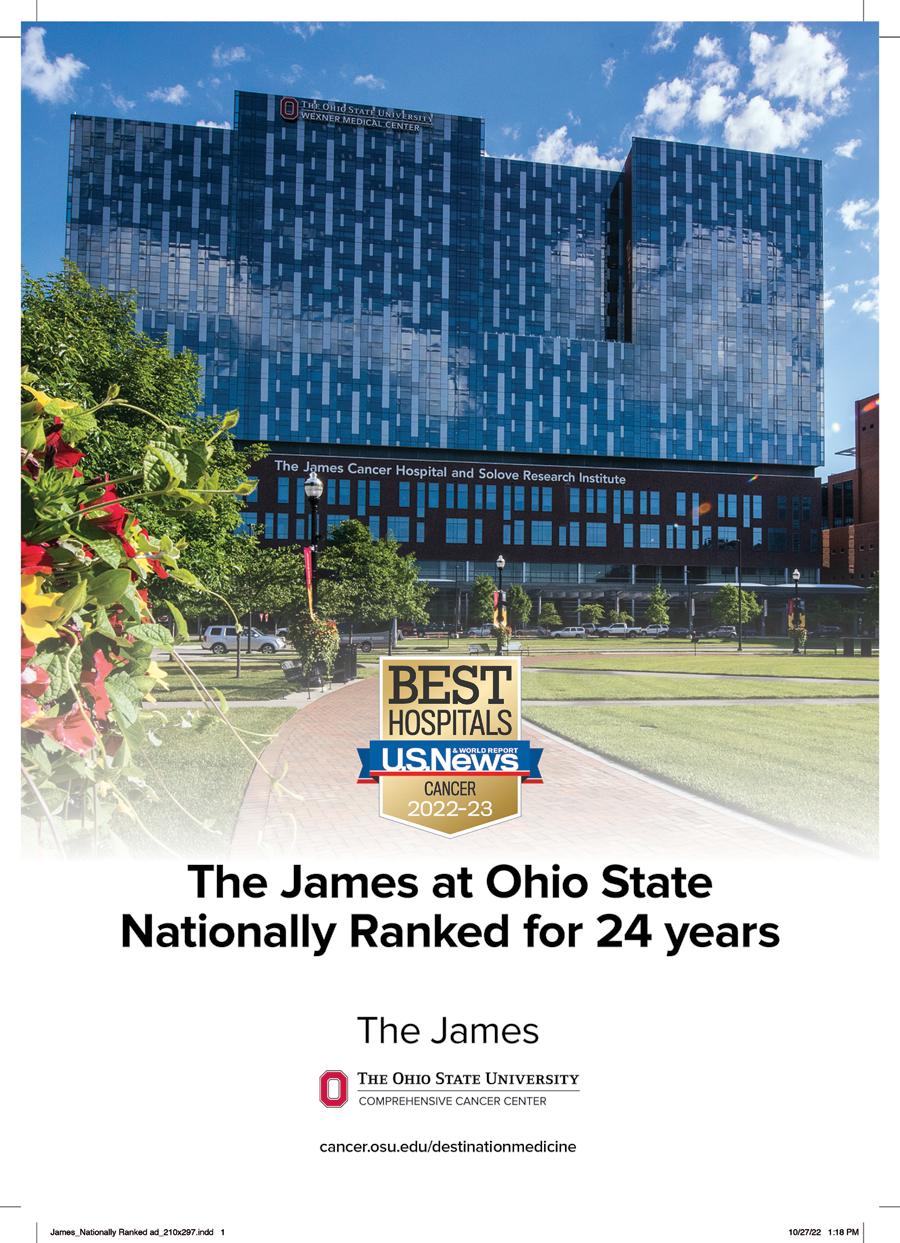
The Ohio State University Comprehensive Cancer CenterJames Cancer Hospital and Solove Research Institute


Beating cancer with ground-breaking research and excellent patient-centered care
The Ohio State University Comprehensive Cancer Center – Arthur G. James Cancer Hospital and Richard J. Solove Research Institute (OSUCCC – James) [1] is dedi cated to creating a cancer-free world by in tegrating scientific research with excellence in education and patient-centered care – a strategy that leads to better methods of pre vention, detection and treatment.
Ohio State is one of 53 National Cancer Institute (NCI)-designated Comprehensive Cancer Centers and one of only a few cen ters funded by the NCI to conduct phase I and II clinical trials on novel anticancer drugs provided by the NCI. 2021 marked the 45th anniversary of the university’s des ignation by the NCI as a Comprehensive Cancer Center, a designation competitively maintained since 1976. In its last three formal reviews for five-year re-designation, the university’s cancer program, embodied in the OSUCCC – James, has received the NCI’s highest descriptor of “exceptional”.
Cancer research
The OSUCCC – James has more than $105 million in active cancer-relevant funding, and $61.5 million of that total – more than half – comes from the NCI. In 2021 alone, Ohio State cancer researchers received 28 new research grants totaling $11.1 million from the NCI, placing the cancer program in the top 20 cancer institutions in the United States for total NCI funding.
The OSUCCC – James has nearly 360 full or introductory cancer researchers who collectively represent 11 of the 15 col leges at Ohio State. Each researcher is a member of one of five multidisciplinary research programs: Cancer Control, Leukemia Research, Cancer Biology, Molecular Carcinogenesis and Chemoprevention, or Translational Therapeutics. In 2021, these researchers authored or co-authored 824 publications in peer-reviewed journals, in cluding 174 in journals with impact factors of 10 or higher. Also, 98% of all articles published were collaborative, and over 96% were multi-institutional.
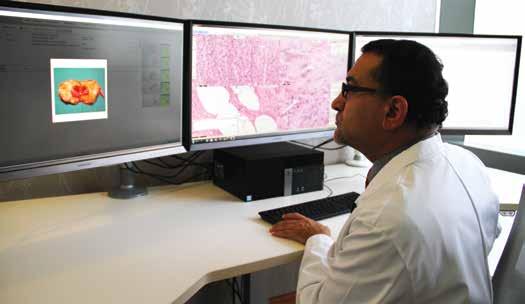
In addition, OSUCCC – James research ers lead or assist with nearly 700 clinical trials offering the latest cancer treatments,
The patient accrual rate for clinical tri als at the OSUCCC – James is 15%, well above the 3% national average.
Patient care
As the cancer program’s 356-bed adult patient-care component, The James is the third-largest cancer hospital in the country and one of the top cancer hospitals in the nation as ranked by U.S. News & World Re port. With 21 floors and more than 1.1 million square feet, The James is a transforma tional facility that fosters collaboration and integration of cancer research and clinical care. Because early diagnosis is the key to successful cancer treatment, the OSUCCC – James opened The James Cancer Diag nostic Center to provide patients who may have cancer with direct, expedited access to diagnostic testing in a center that is open for same-day or next-day appointments.
The OSUCCC – James since 2014 has enrolled more than 63,000 patients in a ‘Total Cancer Care’ (TCC) protocol for voluntarily sharing de-identified clinical data that advances cancer research and personalizes cancer care. The TCC protocol has been adopted by all 18 member insti tutions across the United States that con stitute the Oncology Research Information Exchange Network (ORIEN) [2], a research
collaboration co-founded and co-anchored by the OSUCCC – James and Moffit Can cer Center in Tampa, Florida. Through ORIEN, TCC-consented patients across the nation donate clinical data for research that helps scientists better understand can cer at the molecular level.
International reputation
Because of its international reputation for providing outstanding research-based cancer care, the OSUCCC – James is regarded as a global destination of choice, serving pa tients from all 50 U.S. states, three U.S ter ritories and 85 other countries. The institution’s ‘Destination Medicine Global Health Care’ team [3] is dedicated to ensuring that distance and language are no obstacles to receiving the internationally recognized cancer care available at Ohio State.
References
1. https://cancer.osu.edu/ 2. https://www.oriencancer.org/the-orien-difference
3. https://cancer.osu.edu/for-patients-and-caregivers/international-and-out-of-state-patients-guide
MIDDLE EAST HEALTHI 13
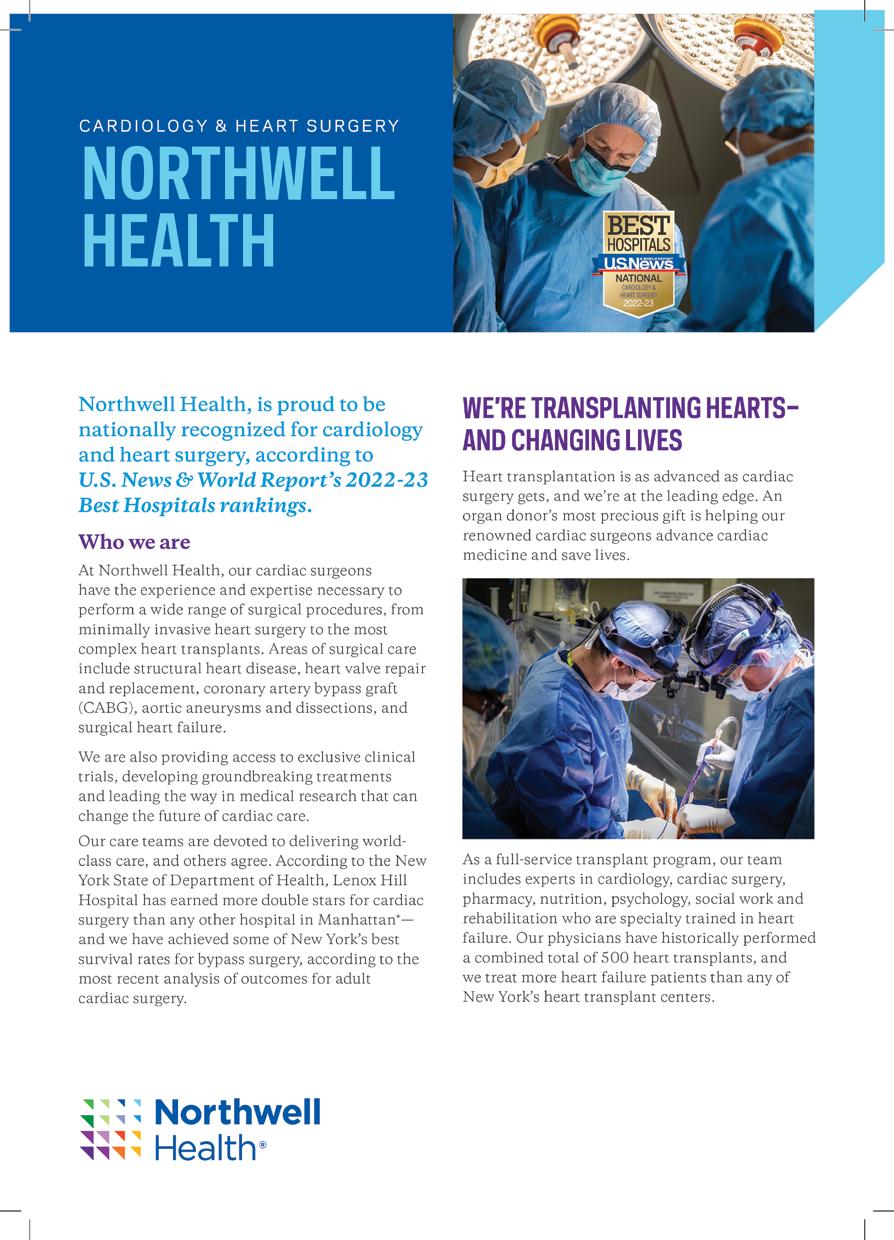

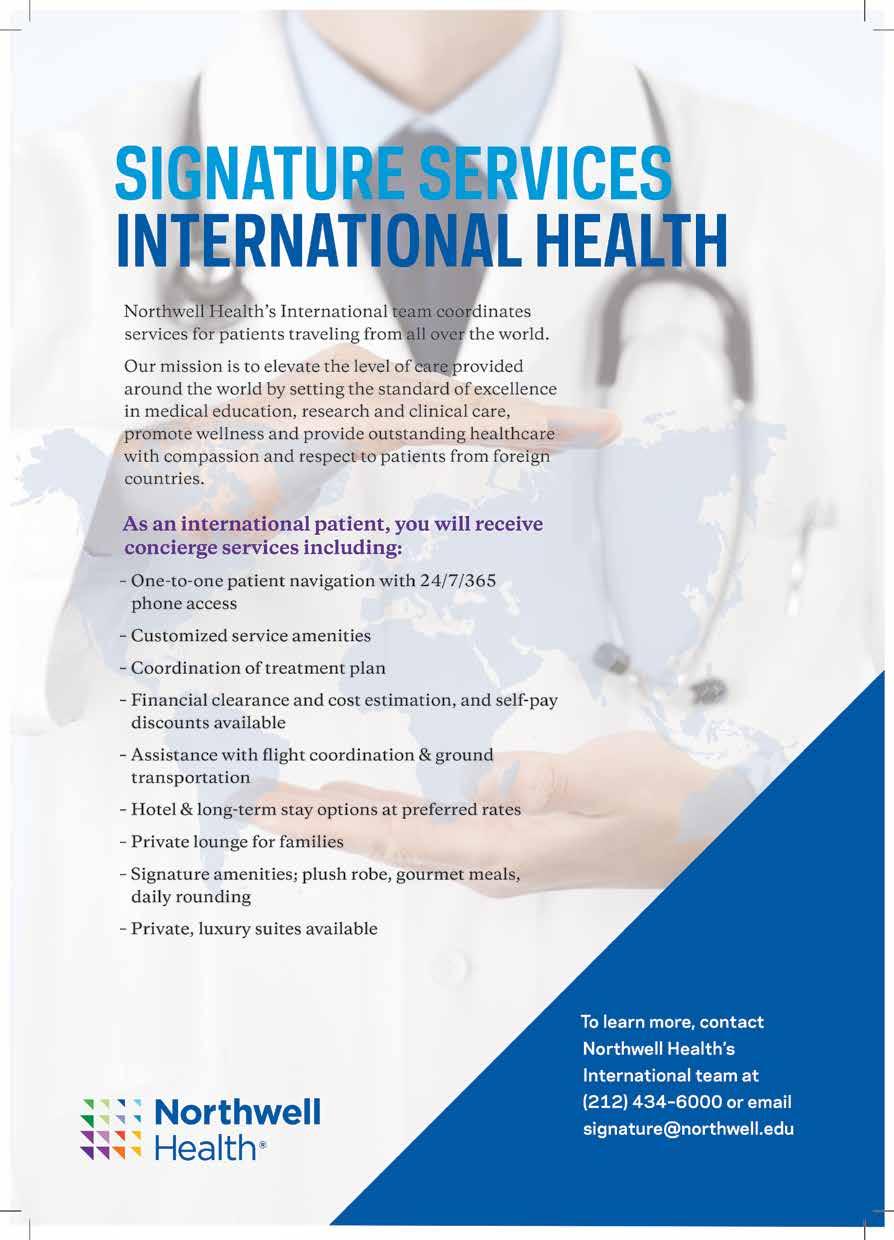


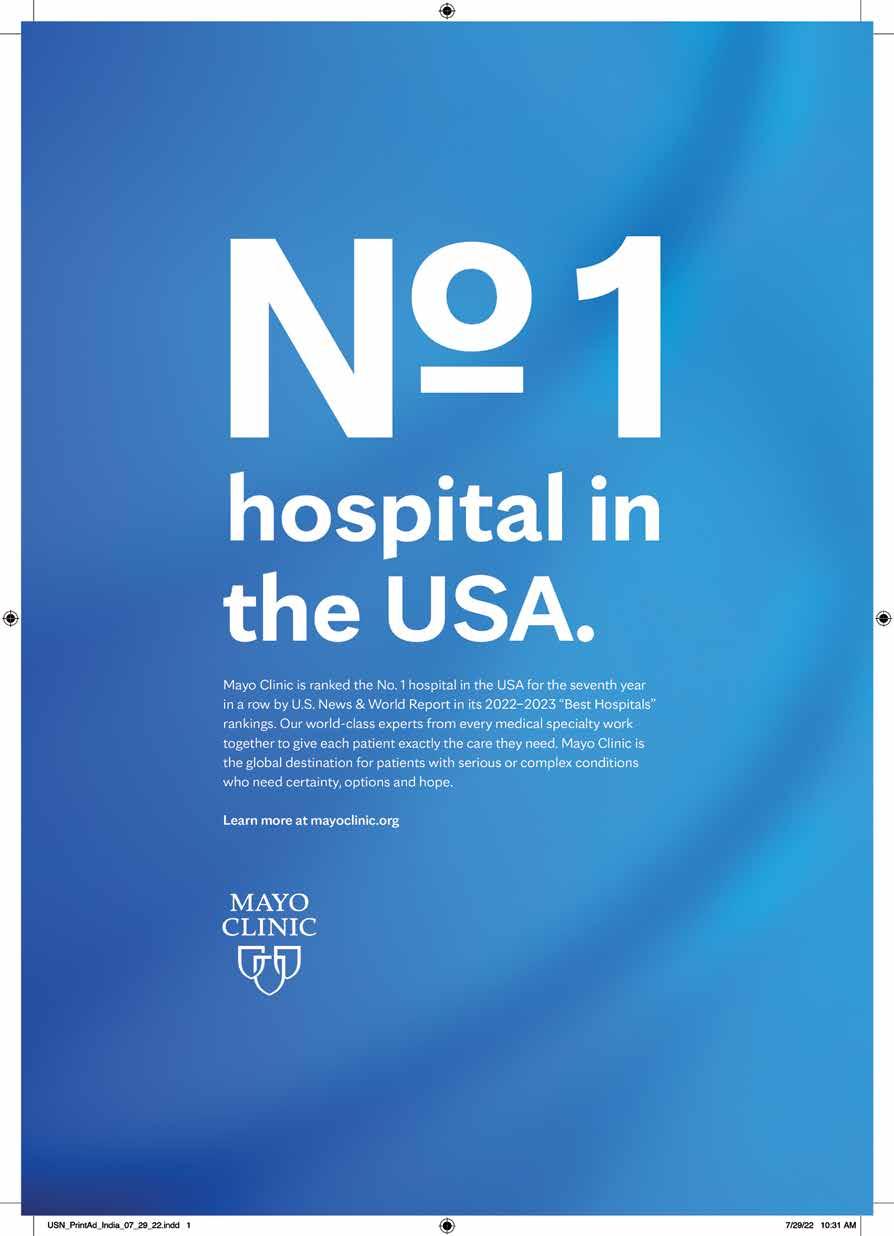















 By John Fernandez
By John Fernandez












